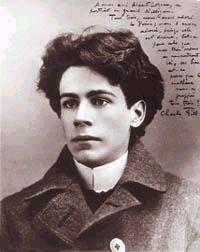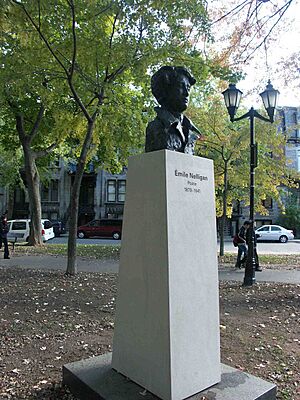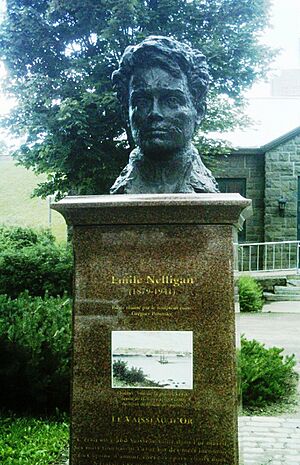Émile Nelligan facts for kids
Quick facts for kids
Émile Nelligan
|
|
|---|---|

Nelligan in 1899
|
|
| Born | 24 December 1879 |
| Died | 18 November 1941 (aged 61) |
| Occupation | Poet |
Émile Nelligan (December 24, 1879 – November 18, 1941) was a Canadian Symbolist poet from Montreal who wrote in French. Even though he stopped writing poetry after being institutionalized at the age of 19, Nelligan remains an iconic figure in Quebec culture and was considered by Edmund Wilson to be the greatest Canadian poet in any language.
Biography
Nelligan was born in Montreal on December 24, 1879, at 602, rue de La Gauchetière (Annuaire Lovell's de 1879). He was the first son of David Nelligan, who arrived in Quebec from Dublin, Ireland at the age of 12. His mother was Émilie Amanda Hudon, from Rimouski, Quebec. He had two sisters, Béatrice and Gertrude.
A follower of Symbolism, he produced poetry profoundly influenced by Octave Crémazie, Louis Fréchette, Charles Baudelaire, Paul Verlaine, Georges Rodenbach, Maurice Rollinat and Edgar Allan Poe. A precocious talent like Arthur Rimbaud, he published his first poems in Montreal at the age of 16.
In 1899, Nelligan began to exhibit odd behavior. He was said to have loudly recited poetry to passing strangers and slept in chapels. He was committed to a mental hospital at the request of his parents. There he was diagnosed with dementia praecox (now more commonly referred to as schizophrenia). He did not write any poetry after being hospitalized.
At the time, rumor and speculation suggested that he went insane because of the vast cultural and language differences between his mother and father. In recent years, however, a number of literary critics have theorized that Nelligan may have been gay. No biographical sources published during Nelligan's lifetime contain any confirmed record of Nelligan having had any relationships with either men or women, although some posthumous biographers have suggested that he may have been the lover of poet Arthur de Bussières.
In 1903, his collected poems were published to great acclaim in Canada. He may not have been aware that he was counted among French Canada's greatest poets.
On his death in 1941, Nelligan was interred in the Cimetière Notre-Dame-des-Neiges in Montreal, Quebec. Following his death, the public became increasingly interested in Nelligan. His incomplete work spawned a kind of romantic legend. He was first translated into English in 1960 by P.F. Widdows. In 1983, Fred Cogswell translated all his poems in The Complete Poems of Émile Nelligan. In the fall of 2017, Montreal's Vehicle Press will be releasing Marc di Saverio's English translations of Nelligan, Ship of Gold: The Essential Poems of Emile Nelligan.
Nelligan is considered one of the greatest poets of French Canada. Several schools and libraries in Quebec are named after him, and Hotel Nelligan is a four-star hotel in Old Montreal at the corner of Rue St. Paul and Rue St. Sulpice.
In her 2013 book Le Naufragé du Vaisseau d'or, Yvette Francoli claimed that Louis Dantin, the publisher of Nelligan's poems, was in fact their real author. This claim was also previously advanced by Claude-Henri Grignon in his 1936 essay Les Pamphlets de Valdombre, although Dantin himself denied having had anything more than an editing role in the poems' creation. In 2016, the University of Ottawa's literary journal Analyses published an article by Annette Hayward and Christian Vandendorpe which rejected the claim, based on textual comparisons of the poetry credited to Nelligan with the writings of Dantin.
Le Vaisseau d'Or
Ce fut un grand Vaisseau taillé dans l'or massif:
Ses mâts touchaient l'azur, sur des mers inconnues;
La Cyprine d'amour, cheveux épars, chairs nues,
S'étalait à sa proue, au soleil excessif.
Mais il vint une nuit frapper le grand écueil
Dans l'Océan trompeur où chantait la Sirène,
Et le naufrage horrible inclina sa carène
Aux profondeurs du Gouffre, immuable cercueil.
Ce fut un Vaisseau d'Or, dont les flancs diaphanes
Révélaient des trésors que les marins profanes,
Dégoût, Haine et Névrose, entre eux ont disputés.
Que reste-t-il de lui dans sa tempête brève?
Qu'est devenu mon coeur, navire déserté?
Hélas! Il a sombré dans l'abîme du Rêve!
English-language translation/adaptation for "Nelligan, the Musical" by Michel Tremblay and Andre Gagnon
A vessel of great might / Was hewn of solid gold / Masts billowed in the air / On seas beyond compare
There Venus came in sight / Bare-skinned with tousled hair / Spread upon the prow for sunlight to behold
But then came fateful night / A great reef sealed her doom / In the deceiving ocean / Wherein sirens sing
Her hull was tilted forth / The wreck slipped tapering / Down to the chasm's depths / Toward a silent tomb
A vessel hewn of gold / Diaphanous as air / Revealed its treasure hold / To vulgar sailors, there
Disgust and Hate and Fear / Amongst themselves did rage /
The vessel's gone amiss / In sudden storm it seems / What's happened to my heart, lost on the thankless waves? /
Alas! It sank into the dark abyss... of dreams
Christ en Croix
Je remarquais toujours ce grand Jésus de plâtre
Dressé comme un pardon au seuil du vieux couvent,
Échafaud solennel à geste noir, devant
Lequel je me courbais, saintement idolâtre.
Or, l'autre soir, à l'heure où le cri-cri folâtre,
Par les prés assombris, le regard bleu rêvant,
Récitant Eloa, les cheveux dans le vent,
Comme il sied à l'Éphèbe esthétique et bellâtre,
J'aperçus, adjoignant des débris de parois,
Un gigantesque amas de lourde vieille croix
Et de plâtre écroulé parmi les primevères;
Et je restai là, morne, avec les yeux pensifs,
Et j'entendais en moi des marteaux convulsifs
Renfoncer les clous noirs des intimes Calvaires!
Translation by Konrad Bongard
The gypsum Jesus always stalled me in my steps
Like a curse at the old convent door;
Crouching meekly, I bend to exalt an idol
Whose forgiveness I do not implore.
Not long ago, at the crickets' hour, I roamed dim
Meadows in a restful reverie
Reciting 'Eloa', with my hair worn by the wind
And no audience save for the trees.
But now, as I lie with knees bent beneath Christ's scaffold,
I see his crumbling mortar cross
With its plaster buried in the roses, and am saddened -
For if I listen close enough, I can almost hear
The sound of coal-black nails being wrung in
To his wrists, the savage piercing of Longinus' spear.
Tribute
Several schools and libraries of Quebec bear the name of Émile Nelligan. Since 1979 the Prix Émile-Nelligan has rewarded the authors of a French-language poetry book written by a young poet in North America.
On June 7, 2005, the Fondation Émile-Nelligan and the City of Montreal inaugurated a bust to his memory in the Carré Saint-Louis. Another monument to his memory stands in Quebec City.
The poetry of Nelligan inspired numerous music composers:
- André Gagnon. Nelligan, Toronto: Disques SRC, 2005, 2 discs (Concert recorded at the Salle Wilfrid-Pelletier of the Place des Arts in Montréal, on February 18 and 19 2005)
- Gilbert Patenaude. Compagnons des Amériques : poètes québécois mis en musique, Montréal: Disques XXI, 2005, 1 disc
- Jean Chatillon. Clair de lune sur les eaux du rêve, Bécancour: Éditions de l'Écureuil noir, 2001 (1 disc)
- Jacques Hétu. Le tombeau de Nelligan : mouvement symphonique opus 52, Saint-Nicolas: Doberman-Yppan, 1995 (1 partition: 44 pages)
- John Craton. Jardin sentimental : Cinq poèmes d'Émile Nelligan, Bedford, Ind: Wolfhead Music, 2004, 18 pages.
- André Gagnon and Claude Léveillée. Monique Leyrac chante Emile Nelligan, Verdun: Disques Mérite, 1991, 1 disc
- André Gagnon. Nelligan : livret d'opéra, Montréal: Leméac, 1990, 90 pages (text by Michel Tremblay)
- Jacques Hétu. Les abîmes du rêve : opus 36, Montréal: Sociéte nouvelle d'enregistrement, 1987, duration 30:21
- Richard G. Boucher. Anges maudits, veuillez m'aider! : cantate dramatique sur des poèmes d'Émile Nelligan, Montréal: Radio Canada international, 1981, duration 38 min.
- Omer Létourneau. Violon de villanelle : choeur pour voix de femmes, Québec: Procure générale de musique enr., 1940 (1 partition: 8 pages)
See also
 In Spanish: Émile Nelligan para niños
In Spanish: Émile Nelligan para niños



